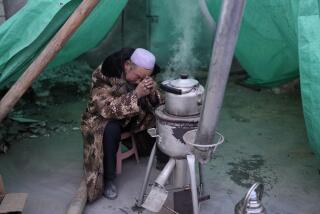In China’s Cold North, the Kang Is King
- Share via
HUACHUAN, China — Li Xiulan says that for all of her 73 winters in China’s frigid northeast, her best weapon against the biting cold has been a pile of bricks.
Like millions of northern Chinese, Li wakes up every morning on a kang -- a traditional brick sleeping platform heated from below by burning straw or coal during the long, dark winter months.
“Without the kang, winter would be unbearable,” she said, bundled in layers of sweaters and warming her hands before its gentle heat in her grandchildren’s bedroom.
Environmentalists worry that kangs waste energy and add to air pollution. But people here say it’s the only way to survive in China’s version of Siberia, where the winter sun sets at 3 p.m. and temperatures can plunge to 40 below zero.
For centuries, the kang has been the center of winter life in the northeast. Families crowd together on them to sleep under mountains of quilts. Children play on them during the day, and parents do as many chores on them as they can.
“All day, if there’s nothing else to do, we’re on the kang,” said Zhou Yuyong, a 27-year-old soybean farmer on the outskirts of Huachuan, a town near the border with Russia.
In Beijing and other northern cities, traditional homes with kangs have fallen victim to the wrecking ball, making way for apartment blocks with steam radiators. Cities have banned the burning of the coal bricks that fueled kangs and contributed to eye-searing smog.
But in the countryside, kangs have survived the arrival of electricity, cellphones and the Internet. Families gather on them to watch satellite TV and DVDs.
An estimated 80% to 90% of farm families in China’s northeast use kangs, said Wang Hongyang, a professor at the Resource and Environment Institute of Northeastern Agricultural University in Harbin, capital of China’s northernmost province, Heilongjiang.
Scientists warn that kangs waste fuel, pollute the air and pose a health hazard by releasing carbon monoxide and other dangerous gases indoors.
Towns throughout the northeast become wreathed in smoke as families fire up their kangs for the evening. The houses of more prosperous residents emit the odor of burning coal.
“In order to protect the environment, the government should encourage and guide farmers to give up using kangs,” Wang said. “But the kang cannot be phased out in a short time, because the farmers in these areas depend on them.”
The government and environmental groups have sponsored research to produce alternatives using such energy as natural gas from decomposing farm waste.
But for many families, the kang is close to perfect.
The furnace doubles as heat for the kitchen stove and burns cornstalks and other vegetation, free byproducts of the farmers’ crops. The bricks soak up heat, releasing it through the night.
Some tourist hotels in Beijing and elsewhere have tried to bring in tourists looking for a taste of old China by installing kangs heated by electricity.
Preparing for winter dominates life in China’s northeast, the region once known as Manchuria.
Hundreds of cabbages, a hardy vegetable that keeps for months, are stacked like firewood in yards. The south-facing walls of some homes are almost entirely glass, double- and tripled-layered for a greenhouse effect from the few hours of daily sunlight in the dead of winter.
“If the windows were smaller, there would be no sunshine and it would be freezing in here,” Zhou, the soybean farmer, said as she stood in her father-in-law’s parlor.
In the yard outside, icicles dangled from a mop -- at 2 p.m.
“When it gets cold, everyone has to have a kang,” said Zhou’s father-in-law, Dou Zhiquan, 56. “Without one, you can’t survive the winter.”
More to Read
Sign up for Essential California
The most important California stories and recommendations in your inbox every morning.
You may occasionally receive promotional content from the Los Angeles Times.













